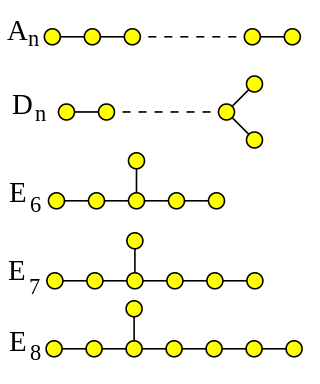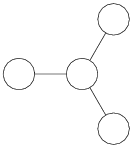Related Research Articles

In the mathematical field of Lie theory, a Dynkin diagram, named for Eugene Dynkin, is a type of graph with some edges doubled or tripled. Dynkin diagrams arise in the classification of semisimple Lie algebras over algebraically closed fields, in the classification of Weyl groups and other finite reflection groups, and in other contexts. Various properties of the Dynkin diagram correspond to important features of the associated Lie algebra.

In mathematics, E6 is the name of some closely related Lie groups, linear algebraic groups or their Lie algebras , all of which have dimension 78; the same notation E6 is used for the corresponding root lattice, which has rank 6. The designation E6 comes from the Cartan–Killing classification of the complex simple Lie algebras (see Élie Cartan § Work). This classifies Lie algebras into four infinite series labeled An, Bn, Cn, Dn, and five exceptional cases labeled E6, E7, E8, F4, and G2. The E6 algebra is thus one of the five exceptional cases.

In mathematics, in particular the theory of Lie algebras, the Weyl group of a root system Φ is a subgroup of the isometry group of that root system. Specifically, it is the subgroup which is generated by reflections through the hyperplanes orthogonal to the roots, and as such is a finite reflection group. In fact it turns out that most finite reflection groups are Weyl groups. Abstractly, Weyl groups are finite Coxeter groups, and are important examples of these.
In mathematics, an algebraic torus, where a one dimensional torus is typically denoted by , , or , is a type of commutative affine algebraic group commonly found in projective algebraic geometry and toric geometry. Higher dimensional algebraic tori can be modelled as a product of algebraic groups . These groups were named by analogy with the theory of tori in Lie group theory. For example, over the complex numbers the algebraic torus is isomorphic to the group scheme , which is the scheme theoretic analogue of the Lie group . In fact, any -action on a complex vector space can be pulled back to a -action from the inclusion as real manifolds.
In mathematics, the outer automorphism group of a group, G, is the quotient, Aut(G) / Inn(G), where Aut(G) is the automorphism group of G and Inn(G) is the subgroup consisting of inner automorphisms. The outer automorphism group is usually denoted Out(G). If Out(G) is trivial and G has a trivial center, then G is said to be complete.

In mathematics, the ADE classification is a situation where certain kinds of objects are in correspondence with simply laced Dynkin diagrams. The question of giving a common origin to these classifications, rather than a posteriori verification of a parallelism, was posed in. The complete list of simply laced Dynkin diagrams comprises

In mathematics, E7 is the name of several closely related Lie groups, linear algebraic groups or their Lie algebras e7, all of which have dimension 133; the same notation E7 is used for the corresponding root lattice, which has rank 7. The designation E7 comes from the Cartan–Killing classification of the complex simple Lie algebras, which fall into four infinite series labeled An, Bn, Cn, Dn, and five exceptional cases labeled E6, E7, E8, F4, and G2. The E7 algebra is thus one of the five exceptional cases.

In mathematics, triality is a relationship among three vector spaces, analogous to the duality relation between dual vector spaces. Most commonly, it describes those special features of the Dynkin diagram D4 and the associated Lie group Spin(8), the double cover of 8-dimensional rotation group SO(8), arising because the group has an outer automorphism of order three. There is a geometrical version of triality, analogous to duality in projective geometry.

In mathematics, a reductive group is a type of linear algebraic group over a field. One definition is that a connected linear algebraic group G over a perfect field is reductive if it has a representation with finite kernel which is a direct sum of irreducible representations. Reductive groups include some of the most important groups in mathematics, such as the general linear group GL(n) of invertible matrices, the special orthogonal group SO(n), and the symplectic group Sp(2n). Simple algebraic groups and (more generally) semisimple algebraic groups are reductive.

In mathematics, a Lie algebra is semisimple if it is a direct sum of simple Lie algebras..

In mathematics, specifically in group theory, the phrase group of Lie type usually refers to finite groups that are closely related to the group of rational points of a reductive linear algebraic group with values in a finite field. The phrase group of Lie type does not have a widely accepted precise definition, but the important collection of finite simple groups of Lie type does have a precise definition, and they make up most of the groups in the classification of finite simple groups.
In mathematics, a Ree group is a group of Lie type over a finite field constructed by Ree from an exceptional automorphism of a Dynkin diagram that reverses the direction of the multiple bonds, generalizing the Suzuki groups found by Suzuki using a different method. They were the last of the infinite families of finite simple groups to be discovered.
In arithmetic geometry, the Weil–Châtelet group or WC-group of an algebraic group such as an abelian variety A defined over a field K is the abelian group of principal homogeneous spaces for A, defined over K. John Tate (1958) named it for François Châtelet (1946) who introduced it for elliptic curves, and André Weil (1955), who introduced it for more general groups. It plays a basic role in the arithmetic of abelian varieties, in particular for elliptic curves, because of its connection with infinite descent.
In mathematics, a field F is called quasi-algebraically closed (or C1) if every non-constant homogeneous polynomial P over F has a non-trivial zero provided the number of its variables is more than its degree. The idea of quasi-algebraically closed fields was investigated by C. C. Tsen, a student of Emmy Noether, in a 1936 paper (Tsen 1936); and later by Serge Lang in his 1951 Princeton University dissertation and in his 1952 paper (Lang 1952). The idea itself is attributed to Lang's advisor Emil Artin.
In representation theory, a branch of mathematics, the Langlands dualLG of a reductive algebraic group G is a group that controls the representation theory of G. If G is defined over a field k, then LG is an extension of the absolute Galois group of k by a complex Lie group. There is also a variation called the Weil form of the L-group, where the Galois group is replaced by a Weil group. Here, the letter L in the name also indicates the connection with the theory of L-functions, particularly the automorphic L-functions. The Langlands dual was introduced by Langlands (1967) in a letter to A. Weil.
In the mathematical study of Lie algebras and Lie groups, a Satake diagram is a generalization of a Dynkin diagram introduced by Satake (1960, p.109) whose configurations classify simple Lie algebras over the field of real numbers. The Satake diagrams associated to a Dynkin diagram classify real forms of the complex Lie algebra corresponding to the Dynkin diagram.

In mathematics, the notion of a real form relates objects defined over the field of real and complex numbers. A real Lie algebra g0 is called a real form of a complex Lie algebra g if g is the complexification of g0:
In mathematics, the Steinberg triality groups of type 3D4 form a family of Steinberg or twisted Chevalley groups. They are quasi-split forms of D4, depending on a cubic Galois extension of fields K ⊂ L, and using the triality automorphism of the Dynkin diagram D4. Unfortunately the notation for the group is not standardized, as some authors write it as 3D4(K) (thinking of 3D4 as an algebraic group taking values in K) and some as 3D4(L) (thinking of the group as a subgroup of D4(L) fixed by an outer automorphism of order 3). The group 3D4 is very similar to an orthogonal or spin group in dimension 8.

In algebra, a simple Lie algebra is a Lie algebra that is non-abelian and contains no nonzero proper ideals. The classification of real simple Lie algebras is one of the major achievements of Wilhelm Killing and Élie Cartan.
References
- Lang, Serge (1956), "Algebraic groups over finite fields", American Journal of Mathematics , 78: 555–563, doi:10.2307/2372673, ISSN 0002-9327, JSTOR 2372673, MR 0086367